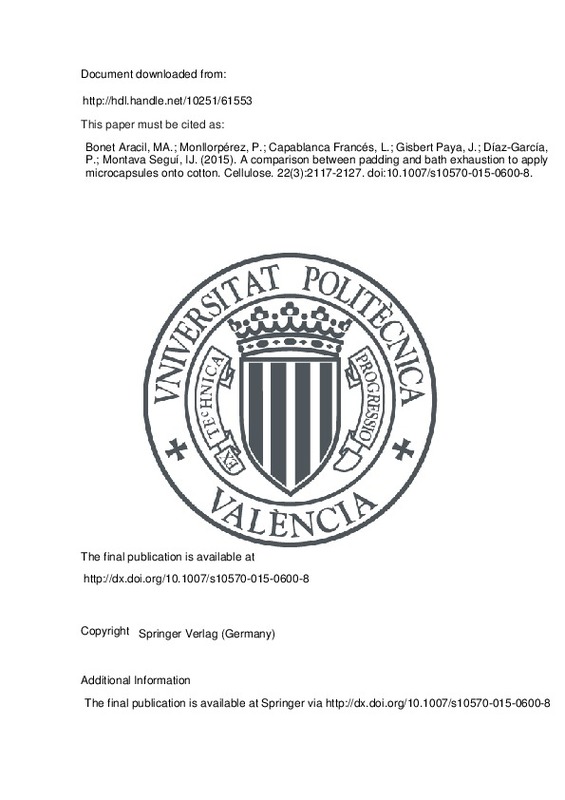Bonet M, Quijada C, Muñoz S, Cases F (2004) Characterization of ethylcellulose with different degrees of substitution (DS): a diffuse-reflectance infrared study. Can J Anal Sci Spectrosc 49(4):234–239
Bonet M, Capablanca L, Monllor P, Díaz P, Montava I (2012) Studying bath exhaust as a method to apply microcapsules on fabrics. J Text Inst 103(6):629–635
Buchert J, Pere LS, Johanson JM, Campbell J (2001) Analysis of surface chemistry of linen and cotton fabrics. Text Res J 71:626–629
[+]
Bonet M, Quijada C, Muñoz S, Cases F (2004) Characterization of ethylcellulose with different degrees of substitution (DS): a diffuse-reflectance infrared study. Can J Anal Sci Spectrosc 49(4):234–239
Bonet M, Capablanca L, Monllor P, Díaz P, Montava I (2012) Studying bath exhaust as a method to apply microcapsules on fabrics. J Text Inst 103(6):629–635
Buchert J, Pere LS, Johanson JM, Campbell J (2001) Analysis of surface chemistry of linen and cotton fabrics. Text Res J 71:626–629
Fras L, Johanson LS, Stenius P, Laine P, Stana-Kleinscheck K, Ribitsch V (2005) Analysis of theoxidation of cellulosefibresbytitration and XPS. Colloids Surf A 260:101–108
Gisbert G, Ibañez F, Bonet M, Monllor P, Díaz P, Montava I (2009) Increasing hydration of the epidermis by microcapsules in sterilized products. J Appl Polym Sci 113(4):2282–2286
Hong K, Park S (1999) Melamine resin microcapsules containing fragant oil: synthesis and characterization. J Appl Polym Sci 58:128–131
Jing HU, Zuobing X, Rujun Z, Shuangshuang M, Mingxi W, Zhen L (2011) Properties of aroma sustained-release cotton fabric with rose fragrance nanocapsule. Chin J Chem Eng 19(3):523–528
Kokot S, Czarnik-Matusewicz C, Ozaki Y (2002) Two- dimensional correlation spectroscopy and principal component analysis studies of temperature-dependent IR spectra of cotton-cellulose. Biopolymers 67:456–469
Kondo T, Sawatari C, Manley RJ, Gray DG (1994) Characterization of hydrogen bonding in cellulose synthetic polymer blend systems with regioselectively substituted methylcellulose. Macromolecules 27(1):210–215
Miró Specos MM, Escobar G, Marino P, Puggia C, Defain Tesoriero MV, Hermida L (2010) Aroma finishing of cotton fabrics by means of microencapsulation techniques. J Ind Text 40(1):13–32
Monllor P, Bonet M, Cases F (2007) Characterization of the behaviour of flavour microcapsules in cotton fabrics. Eur Polym J 43:2481–2490
Monllor P, Bonet M, Sánchez L, Cases F (2009) Thermal behaviour of microencapsulated flavours when applied to cellulose fabrics. Text Res J 79(4):365–380
Monllor P, Capablanca L, Gisbert J, Díaz P, Bonet M (2010) Improvement of microcapsule adhesion to fabrics. Text Res J 80(7):631–635
Nelson G (1991) Microencapsulates in textile coloration and finishing. Rev Prog Color Relat Top 21:72–85
Nelson G (2001) Microencapsulation in textile finishing. Rev Prog Color Relat Top 321:57–64
Nelson G (2002) Application of microencapsulation in textiles. Int J Pharm 242:55–62
Rodrigues SN, Fernandes I, Martins IM, Mata VG, Barreiro F, Rodrigues AE (2008) Microencapsulation of limonene for textiles application. Ind Eng Chem Res 47:4142–4147
Rodrigues SN, Martins, IM, Fernades IP, Gomes PB, Mata VG, Barreiro MF, Rodrigues AE (2009) Scentfashion®: microencapsulated perfumes for textile application. Chem Eng J 149(1–3):463–472. ISSN:1385-8947
Sócrates G (1997) In: Infrared characteristic group frequencies. Tables and charts, 2nd edn
Topalovic T, Nierstrasz VA, Bautista L, Jocic D, Navarro A, Warmoeskerken MMCG (2007) XPS and contact angle study of cotton surface oxidation by catalytic bleaching. Colloids Surf A 296:76–85
Wilson RC, Pfhol WF (2000) Study of crosslinking reactions of melamine/formaldehyde resin with hydroxyl functional polyester by generalized 2-D infrared spectroscopy. Vib Spectrosc 23:13–22
Zhang H, Wang X (2009) Fabrication and performances of microencapsulated phase change materials based on n-octadecane core and resorcinol-modified melamine-formaldehyde shell. Colloids Surf A 332:129–138
[-]







![[Cerrado]](/themes/UPV/images/candado.png)


